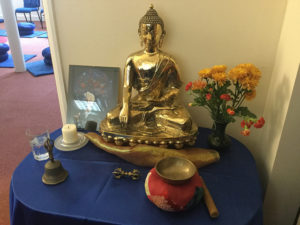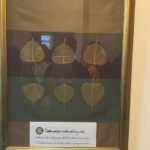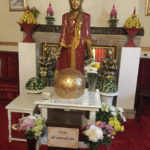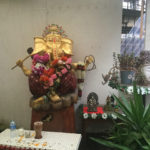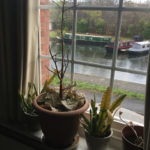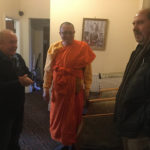Year 2 QTS undergraduates spent a day looking at two forms of Buddhism in Merseyside. Our first visit was to the Triratna Buddhist Centre in Liverpool. Sumnadipa and Janet welcomed us and offered us a drink. Sumnadipa explained her name meant graciousness and lamp, and she was given it when she was ordained. She reminded us that the five precepts have both negative and positive sides, for example the second precept, not taking the not given can also mean living with open handed generosity. She suggested that mindfulness meant taking notice of he things around us. Normally we cannot do this adequately as our ‘monkey minds’ are full of noise and chatter. Meditating, just stopping and being is one was to still the mind and become mindful. Sumnadipa explained some of the fundamental teaching of the Buddha, including the three jewels.
Sumnadipa gave us some of the historical background to the Triratna movement, starting with the life story of Sangharakshita. She explained that Sangharakshita realised that different schools of Buddhism may look quite different and teach different things, because they had taken on the culture of where they are. Underlying his, he suggested there was a core Buddhism, of taking refuge in the three jewels. He set up the Western Buddhist Order to translate the Buddha’s teaching into a form that would appeal to the Modern Western mind. Since the 1960s it has spread worldwide and became the Triratna Community in 2010. Sangharakshita died a few weeks ago aged 93.
She explained some of the differences between the Triratna and other Buddhist schools. Right livelihood appears to be very important in many of their activities and involves both helping others and freeing themselves. We heard how Sumnadipa became a Buddhist, through an initial desire to meditate. She suggested that Sangharakshita might have been a bodhisatva, but people such as the Dalai Lama and Archbishop Desmond Tutu may be enlightened beings.
We finished our time with a meditation session which Sumnadipa led.
A short minibus ride took us to the Wat Phra Singh UK Buddhist Centre in Runcorn. Tony welcomed us and explained that they are from the Thai Therevada tradition. He began by explaining how the two branches of Buddhism developed. Their parent temple is he Wat Phra Singh Chang Mai in Thailand. Tony told us the story of his ordination and how he became Samart, meaning one who achieves. He was ordained in 2008 in Thailand – the first foreigner to be Ordained at Wat Phra Singh Chang Mai, and the last person to be ordained by Lonpornu. The Head monk arrived from Thailand in June 2012, staying with Tony who had a vision for a Temple in the North West of England. The temple opened in June 2014. They now have ambitious plans to build an ubersot – a consecrated Hall.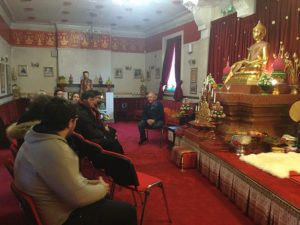
Every morning and evening the monks, who reside on the third floor of the temple, chant and meditate for 45 minutes. One of the rules of the monastic life is that they can only eat before midday. They do duties and learning during the day. There is a free weekly meditation class.
Tony says that he has always been a Buddhist, although he was raised as a Christian, and only became aware as he encountered Buddhist teachings. Other religions say this is right and this is wrong; the dhamma says this is what the Buddha realised. Tony helpfully explained some of the Buddha’s teachings on diverse subjects including kamma, right living, intention and meditation.





